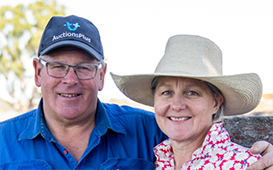Caring for your animals is just good stockmanship
With a family tradition of breeding champion Angus cattle that stretches back more than a century, you could say caring for cattle is in Sam White’s blood.
a family tradition of breeding champion Angus cattle that stretches back more than a century, you could say caring for cattle is in Sam White’s blood.
As LPA-accredited producers, Sam and his wife Kirsty are continuing that tradition on ‘Bald Blair’, the family’s Angus stud and commercial cattle enterprise in the New England Tablelands.
“The herd at Bald Blair has served our family for generations, so good stockmanship is important to us,” Sam said.
“That doesn’t just mean providing them with the basics like feed and water but also seeing that they enjoy a comfortable life for the time they're on our property.”
Almost every paddock across the Whites’ four properties has either a dam or a trough to ensure the animals remain well watered and they also monitor their feedbase constantly to ensure supply is never compromised.
In addition, they have a stock management plan in place, ensuring their stud and commercial cattle are well monitored throughout the year, with weekly stock checks and regular yarding for pregnancy testing, weaning, joining and calf marking.
Shade and shelter
Since Sam returned to Bald Blair in 1990, the goal has been to plant around 1,000 trees annually (conditions permitting) as part of a revegetation program.
“In 2019, with changes in the climate, we saw our animals seeking shelter from the sun and heat more than at any other time since we’ve been here,” Sam said.
The trees look good, but it soon became clear that the benefits weren’t just aesthetic.
“It was interesting to see that the animals who found shade and shelter under the tree cover performed much better than those who hadn’t.”
Socialising your calves
The Whites will yard their calves for a week or so while they’re being weaned and, during this time, they’ll be exposed to dogs, horses, bikes and lots of people.
“That early time spent in the yard is the best time in an animal's life to actually have a real influence on its behaviour – it’s also your best chance to identify and fix an animal with temperament issues, or remove it,” Sam said.
“That early exposure establishes good social habits before an animal even reaches the paddock and they’ll be more relaxed as a result.”
Low-stress stock handling
Sam said they were adamant about employing low-stress stock handling on Bald Blair and believed force isn’t necessary to handle animals.
“Everybody seems to think low-stress stock handling is just walking around with your hands in your pocket and your head down, and it's not,” said Sam.
“It's all about movement and position. If you learn to position yourself correctly, the animals will see you in the same way they see a dog and you'll be able to move anything.”
“You should be exhausted at the end of the day, while your animals should be comfortable and quiet.”
Reducing pain and mismothering
The Whites also run a sheep meat enterprise and say the introduction of Numnuts for pain relief has been a game changer for their lamb marking.
“It only adds five seconds to the marking process, but it means the pain for the lamb only lasts a few minutes and they’ll immediately seek out their mother once they’re put back in with them,” Sam said.
“The animals are just much more settled as a result, and we’ve seen a massive benefit from the reduction in mismothering happening post-marking.”
Sam said reducing the stress and physical impact on the animals was very important to both he and Kirsty.
Ensuring consistency
In addition to the immediate family, the Whites employ two full-time staff members and two to four contractors at any one time.
To ensure uniformity in how their animals are cared for on-farm, the Whites have documented everything to remove any confusion across their workforce.
“We've got a cattle care page on our website for our team which outlines all our requirements, including things like our checklist for lamb marking, how we want our livestock handled, how we do our preg testing, how we do our artificial insemination – it’s all there,” Sam said.
The Whites also provide their staff with a copy of the Cattle Welfare Code of Practice and also go through it with them.
Their staff are also asked to sign a statement on animal welfare, acknowledging they have a duty of care for the welfare of livestock at Bald Blair and its associated properties, based on the Australian Animal Welfare Standards and Guidelines for Cattle.
|
Enhance your animal welfare outcomes Developed in consultation with industry, the new tool is designed to enable producers to demonstrate their compliance with the Australian Animal Welfare Standards through a series of questions tailored around their on-farm operations. Producers can access the tool during their accreditation or reaccreditation process via self-assessment. It will also be available on demand via the record-keeping section. More information |